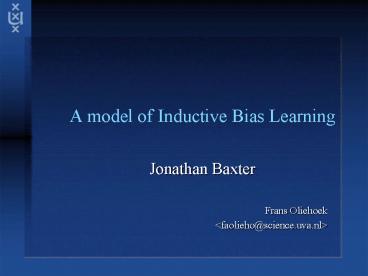A model of Inductive Bias Learning - PowerPoint PPT Presentation
1 / 22
Title:
A model of Inductive Bias Learning
Description:
A model of Inductive Bias Learning. Jonathan Baxter. Frans Oliehoek faolieho_at_science.uva.nl ... Model for learning the inductive bias ... – PowerPoint PPT presentation
Number of Views:113
Avg rating:3.0/5.0
Title: A model of Inductive Bias Learning
1
A model of Inductive Bias Learning
- Jonathan Baxter
- Frans Oliehoek
- ltfaolieho_at_science.uva.nlgt
2
Overview of presentation
- Problem selecting the inductive bias
- Environment of related tasks
- Revision PAC-learning model
- Bias learning model
- Example feature learning
- The covering numbers (?)
- Conclusion
- Questions Discussion
3
Problem selecting the inductive bias
- Important question
- COIL example
- How to choose the hypothesis space?
- Large enough to contain solution
- Small enough to generalize well
- Model for learning the inductive bias
- Assumption learner is embedded in environment
of related tasks
4
Environment of related tasks
- Idea learning a bias for related tasks
- Less examples required per task
- Bias appropriate for new tasks of same type
- Examples
- Handwritten character recognition
- 1 task distinguish A from all characters
- Pre-processing good for all different tasks
- Recognizing n faces
- Learning a bias that is good for recognizing new
faces
5
Revision PAC-learning model
- Input, output space X, Y
- P prob. distr. on X Y
- defines the (non-deterministic) task
- H hypothesis space, h X?Y
- l loss function. l YY?R
- Training error erz(h)
- training set z ((x1,y1),,(xm,ym))
- Generalization error erP(h)
6
Revision PAC-learning model - 2
- Upper bound on number of examples needed for a
certain generalization error by VC-dimension of H - m 1/e ( 4log2(2/d) 8VC(H) log2(13 /e) )
- Gives condition under which erP(h) is likely to
be small, but is no guarantee H should still
contain a good hypothesis! - Bias selection of hypothesis space H
7
Bias learning model
- Goal learning a good bias
- find an appropriate H for
- the environment of related tasks
- prob. distr. P on X Y is a task
- Q is prob. distr. on P
- what tasks the learner is likely to see
- gives environment (P,Q)
- Hypothesis space family H H
8
1 task vs. bias learning
- find h ? H
- erP(h)
- erz(h)
- z ((x1,y1),,(xm,ym))
- sample complexity bounded by VC-dimension
- find H ? H
- erQ(H)
- erz(H)
- z
- (x11,y11) (x1m,y1m)
- .
- (xn1,yn1) (xnm,ynm)
- bounded by covering numbers
9
Uniform convergence for bias learners
- Covering numbers
- capacities related to lower bound on
generalization error and to average loss
functions over n hypotheses - Sample complexity bounds
- Given
- environment (P, Q)
- (n,m) sample z
- n gt
- m gt
- with probability 1-d, all H ? H satisfy erQ(H)
erz(H) e
10
Implications
- Any bias the learner selects can bound erQ(H)
- In order to learn bias such that
- erQ(H) erz(H) e, for all H ? H
- Both m and n need to be sufficiently large
- When a H ? H with small erz(H) has been learned,
this H can be used to learn new related tasks
with improved bounds - Fix d, e Examples required per task, m,
decreases when number of tasks, n, increases. ?
sharing information between tasks
11
Example feature learning
- Feature learning a bias learning problem
- Selecting strong features
- f X?V, maps input to space V of lower dimension
- F f , set of all feature maps
- Then applying classification (regr., etc.)
- g V ? Y, g ? G
- G is a class of functions (H relative to V)
- H Gf gf g ? G for each f
- H Gf f ? F
12
Feature learning 2
- H Hw
- H has W parameters (vij, uij), w is the vector of
parameters - Feature map learns k features, using neural net
of h hidden units
13
Feature learning 3
- We want to learn a good bias
- z (n,m) sample
- locate a Hw with a small erz(Hw)
- erz(Hw) bla
- gradient decent over w and (a1,,ak1)
- What n, m for good generalization?
- given by theorem, but what about capacities?
- for squared loss
14
The covering numbers
- Convergence theorem depends on the covering
numbers - Characteristics of H similar to the VC dimension
of H - We start with
15
The covering numbers 2
- For each H ? H
- function that maps from task P to lower bound
of gen. error - set of all these functions
- pseudo-metric
- difference in gener. error for distribution Q
16
The covering numbers 3
- e-cover of
- is a set
- The size of the smallest e-cover
- Now the capacity of H is
17
Covering numbers 4
- average error of n hypothesis on n different
tasks - all of these functions for a certain H
- the union over the hyp. family
18
Covering numbers 5
- pseudo-metric
- difference in error over a fixed vector of tasks
P - again smallest e-cover
- the capacity of
19
Feature learning contd
- For the network used it can be shown
- Therefore, if
- with probability 1 - d any Hw satisfies
- erQ(H) erz(H) e
20
Choosing the Hypothesis family
- Choosing hyp. space family, H
- which to select?
- hyper-bias
- claimed to be easier
21
Conclusions
- Formal model to bias learning
- Assumption learner embedded in environment of
related tasks - Bounds on sample complexity
- First step to formal model hierarchical learning
22
Discussion questions
- Who starts?

